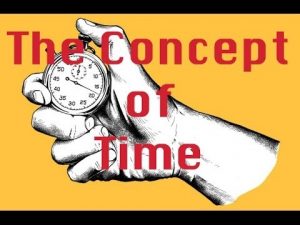Time presents itself to us in many different ways – we label it as good, fair, bad, ugly etc. We measure time, keep time, meet and greet in time because our daily lives are completely wrapped around time. When things slow down, we say time is just not passing, and when we need to achieve too many things we crib that we don’t find sufficient time. We are always on an onward journey in life because time does not wait for anybody and anything. We perceive time as past present and future. And, we store mental picture of time with images and events. Of course, we also cherish photographs of our life. Time is so important in our lives. The greatest discovery in understanding of time occurred about a hundred years ago with Einstein’s theories of Special and General relativity in which he introduced the concept of slowing of time with motion and with gravity.
Time is simply a manmade invention to count the period of events. It does not exist in nature. Since beginnings man has associated events of his life with time, this defines the past, present and future. Time is evolved from sun to indicate parts of a day, to the moon, to indicate part of night. Winter, spring, summer, rainy seasons tell us when to sow seeds and when to harvest. Researchers have inferred that people counted days in relation to the Moon’s phases as early as the Paleolithic age. The concept of month was first used in a modern manner by the Mesopotamian civilization based on the motion of the moon. We human associate with time, whereas it does not exist in the universe.
Hinduism recognizes four great ages: Satya Yuga, Treta Yuga, Dwapar Yuga and Kali Yuga. Satya Yug is recognized as the Age of Truth which is believed to last for four thousand divine years, Treta Yuga for three thousand, Dwapara Yug for two thousand and it is believed that Kali Yuga will last for one thousand divine Years that equals to 432,000 earthly years. It is also believed that three of these great ages have already passed away, and we are now living in the fourth one. What these ages exactly mean, and why this division, it’s hard to explain, because they appear too unrealistic to be true for the rational mind.
We believe in four stages of lifecycle: infancy, growth, maturity and decline. We continuously progress in life, as we progress from one stage to another. Some people find themselves stuck in certain stages for years. While some even skip entire stages completely, without learning the important lessons. Hinduism links the four stages of life to four Ashramas. Each human should ideally go through each of these stages: the first Ashrama – “Brahmacharya” is about the Student Stage. This period is about formal education. It lasts until the age of 25, during which, the youngsters attain both spiritual and practical knowledge of life. This stage comprises of infancy and growth in life cycle.
The second Ashrama is called “Grihastha” This period begins when a human gets married, and undertakes the responsibility for earning a living and supporting family. This ashrama lasts until around the age of 50. This stage can be connected to maturity stage of life cycle, because the person produces kids, earns a living. Human in this stage are forced to think of others. He/she understands that taking decisions is important and taking responsibility for the outcome of decision. When something goes wrong, the human can’t blame others.
The third Ashrama is called “Vanaprasthashrama.” This stage of a man begins when his duty as a householder comes to an end: the children are grown up, and have established lives of their own, and there are grandchildren around. According to the Laws of Manu, when a person’s skin wrinkles and his hair grays, he should go out into the forest.
The fourth Ashrama is called “Sanyasa.” At this stage, a human is supposed to be totally devoted to God. He is a sannyasi, he has no home, no other attachment; he has renounced all desires, fears, hopes, duties and responsibilities. He is virtually merged with God, all his worldly ties are broken, and his sole concern becomes attaining moksha or release from the circle of birth and death. The third and fourth Asramas are connected with decline stage of life. The reality of the four Ashramas is that people tend to prolong the Grihastashrama, they get so attached to this face of life.
Although these Ashramas were predominantly designed for the male, females had a vital role to play in each one of them. So women are not actually excluded because without them, men would not have had families. Today, women are leading more purposeful and active life.
Everything in the universe is moving; once moved ahead, it can’t go back. The universe is changing every second to something different than it was before, it can’t change back. We cannot change our past, but yes, we can change our present and our future. Time is continual movement. To realize the value of one year, look at a student who failed a grade.
To realize the value of one month, look at a mother who has given birth to a premature baby.
To realize the value of an hour, look at the student who is writing an exam and the question paper is long. To realize the value of a minute, ask a person who just missed a train or a flight. Congratulate someone who escaped an accident by split of seconds, that person must have realized value of a second. And, look at the face of a sportsman who won a Gold medal in Olympics, for realizing value of one Millisecond!!
According to a research conducted at the University Of Berkeley, California, people who feel generally more powerful feel they have more time, power makes people have a broader time perspective. Mentally strong people are less stressed, and hence feel they have more time. The flip-side of the experiment is that those who feel powerless, sense the need to struggle with the feeling of not having enough time available to them. Your mental make-up matters a lot.















































